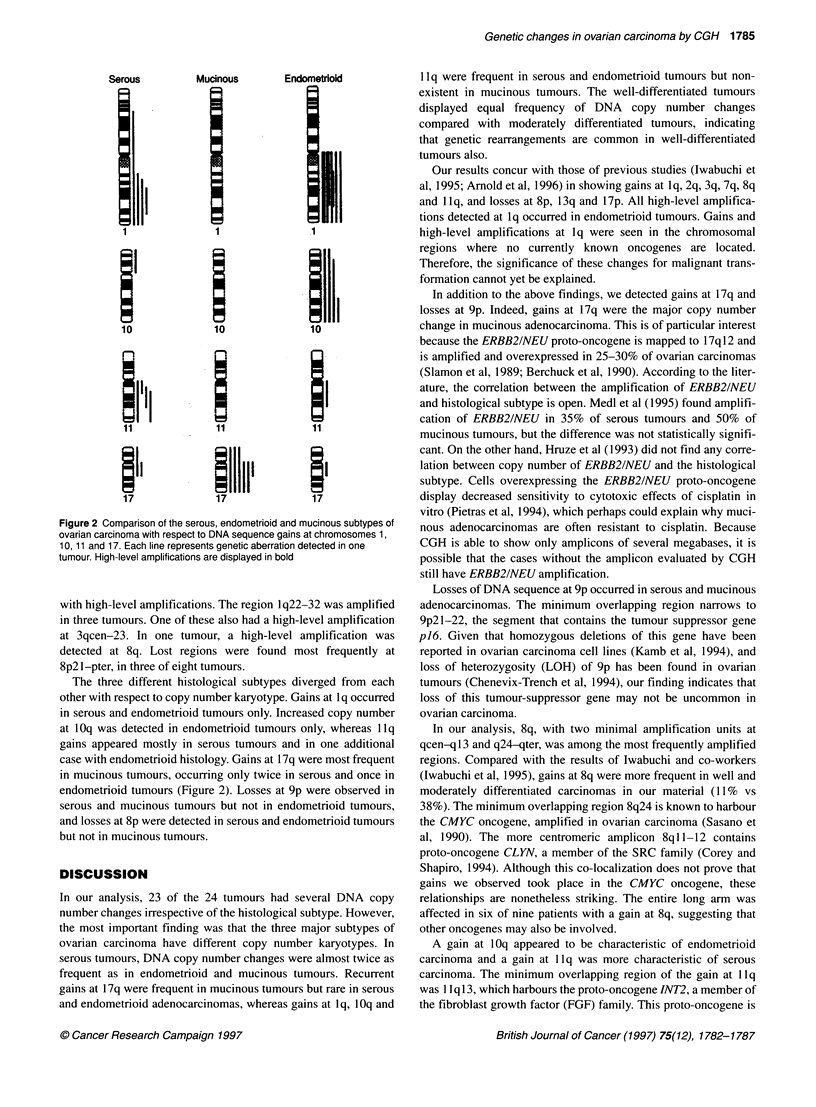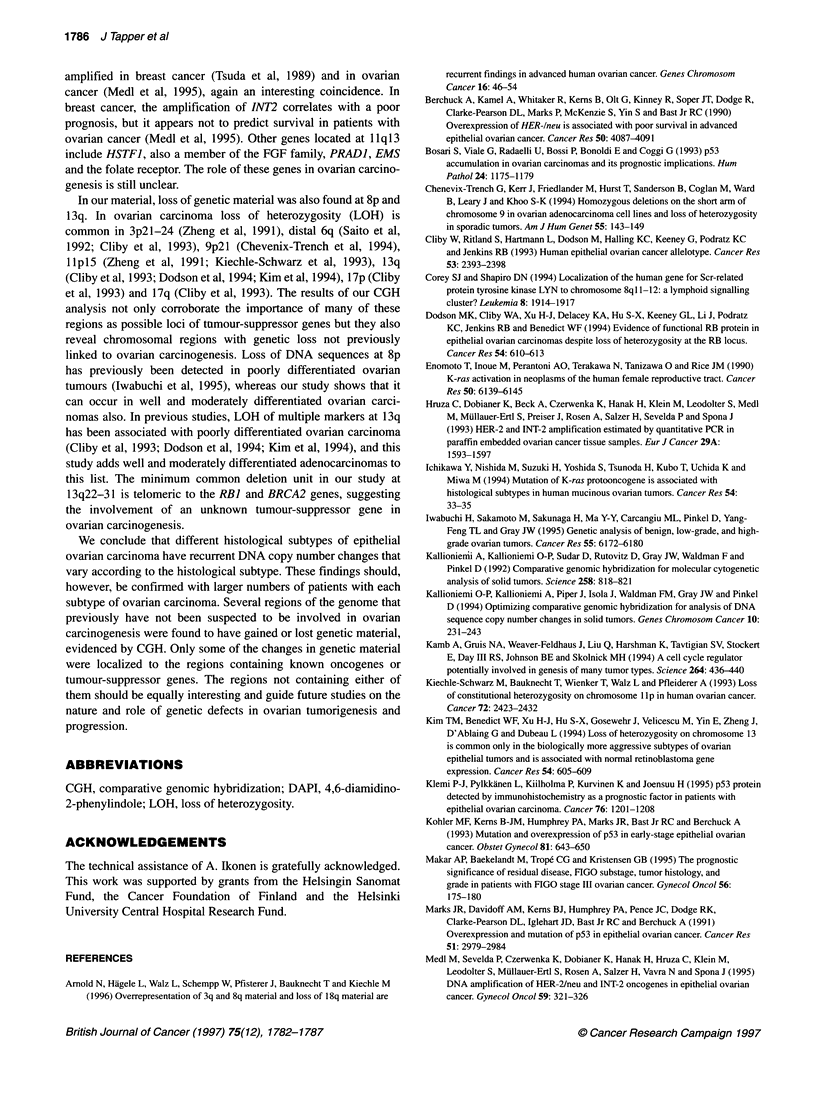Abstract
Comparative genomic hybridization was applied to detect and map changes in DNA copy number in 24 well or moderately differentiated epithelial ovarian carcinomas (eight serous, eight mucinous and eight endometrioid carcinomas). Twenty-three of the 24 tumours showed changes in DNA copy number in one or several regions (median 4, range 1-17). Gains were more frequent than losses (ratio 1.6:1.0). The most frequent gains occurred in chromosomes 1q (38%), 2p (29%), 7q (25%), 8q(38%) and 17q (38%), and the most common losses were located in chromosomes 8p (21%), 9p (25%) and 13q (21%). High-level amplifications were detected in seven tumours at 1q22-32, 2p15-22, 3qcen-23, 6p21-22 and 8q. In the three histological subtypes the copy number karyotypes showed substantial differences. Gains at 1q were observed in endometrioid (five cases) and serous tumours (four cases). Increased copy number at 10q was seen in endometrioid tumours only (four cases), whereas gains at 11q occurred mostly in serous tumours (four cases). In mucinous tumours, the most common copy number change was a gain at 17q (six cases). The results show that, in epithelial ovarian carcinoma, changes in DNA copy number are a rule rather than an exception, chromosomes 1, 2, 7, 8, 9, 13 and 17 being the most frequently affected. The diverging pattern of genetic changes seen in epithelial ovarian carcinomas with different histological phenotypes suggests that various pathways may lead to tumorigenesis and/or progression in these subgroups.
Full text
PDF





Selected References
These references are in PubMed. This may not be the complete list of references from this article.
- Arnold N., Hagele L., Walz L., Schempp W., Pfisterer J., Bauknecht T., Kiechle M. Overrepresentation of 3q and 8q material and loss of 18q material are recurrent findings in advanced human ovarian cancer. Genes Chromosomes Cancer. 1996 May;16(1):46–54. doi: 10.1002/(SICI)1098-2264(199605)16:1<46::AID-GCC7>3.0.CO;2-3. [DOI] [PubMed] [Google Scholar]
- Berchuck A., Kamel A., Whitaker R., Kerns B., Olt G., Kinney R., Soper J. T., Dodge R., Clarke-Pearson D. L., Marks P. Overexpression of HER-2/neu is associated with poor survival in advanced epithelial ovarian cancer. Cancer Res. 1990 Jul 1;50(13):4087–4091. [PubMed] [Google Scholar]
- Bosari S., Viale G., Radaelli U., Bossi P., Bonoldi E., Coggi G. p53 accumulation in ovarian carcinomas and its prognostic implications. Hum Pathol. 1993 Nov;24(11):1175–1179. doi: 10.1016/0046-8177(93)90212-y. [DOI] [PubMed] [Google Scholar]
- Chenevix-Trench G., Kerr J., Friedlander M., Hurst T., Sanderson B., Coglan M., Ward B., Leary J., Khoo S. K. Homozygous deletions on the short arm of chromosome 9 in ovarian adenocarcinoma cell lines and loss of heterozygosity in sporadic tumors. Am J Hum Genet. 1994 Jul;55(1):143–149. [PMC free article] [PubMed] [Google Scholar]
- Cliby W., Ritland S., Hartmann L., Dodson M., Halling K. C., Keeney G., Podratz K. C., Jenkins R. B. Human epithelial ovarian cancer allelotype. Cancer Res. 1993 May 15;53(10 Suppl):2393–2398. [PubMed] [Google Scholar]
- Corey S. J., Shapiro D. N. Localization of the human gene for Src-related protein tyrosine kinase LYN to chromosome 8q11-12: a lymphoid signaling cluster? Leukemia. 1994 Nov;8(11):1914–1917. [PubMed] [Google Scholar]
- Dodson M. K., Cliby W. A., Xu H. J., DeLacey K. A., Hu S. X., Keeney G. L., Li J., Podratz K. C., Jenkins R. B., Benedict W. F. Evidence of functional RB protein in epithelial ovarian carcinomas despite loss of heterozygosity at the RB locus. Cancer Res. 1994 Feb 1;54(3):610–613. [PubMed] [Google Scholar]
- Enomoto T., Inoue M., Perantoni A. O., Terakawa N., Tanizawa O., Rice J. M. K-ras activation in neoplasms of the human female reproductive tract. Cancer Res. 1990 Oct 1;50(19):6139–6145. [PubMed] [Google Scholar]
- Hruza C., Dobianer K., Beck A., Czerwenka K., Hanak H., Klein M., Leodolter S., Medl M., Müllauer-Ertl S., Preiser J. HER-2 and INT-2 amplification estimated by quantitative PCR in paraffin-embedded ovarian cancer tissue samples. Eur J Cancer. 1993;29A(11):1593–1597. doi: 10.1016/0959-8049(93)90301-u. [DOI] [PubMed] [Google Scholar]
- Ichikawa Y., Nishida M., Suzuki H., Yoshida S., Tsunoda H., Kubo T., Uchida K., Miwa M. Mutation of K-ras protooncogene is associated with histological subtypes in human mucinous ovarian tumors. Cancer Res. 1994 Jan 1;54(1):33–35. [PubMed] [Google Scholar]
- Iwabuchi H., Sakamoto M., Sakunaga H., Ma Y. Y., Carcangiu M. L., Pinkel D., Yang-Feng T. L., Gray J. W. Genetic analysis of benign, low-grade, and high-grade ovarian tumors. Cancer Res. 1995 Dec 15;55(24):6172–6180. [PubMed] [Google Scholar]
- Kallioniemi A., Kallioniemi O. P., Sudar D., Rutovitz D., Gray J. W., Waldman F., Pinkel D. Comparative genomic hybridization for molecular cytogenetic analysis of solid tumors. Science. 1992 Oct 30;258(5083):818–821. doi: 10.1126/science.1359641. [DOI] [PubMed] [Google Scholar]
- Kallioniemi O. P., Kallioniemi A., Piper J., Isola J., Waldman F. M., Gray J. W., Pinkel D. Optimizing comparative genomic hybridization for analysis of DNA sequence copy number changes in solid tumors. Genes Chromosomes Cancer. 1994 Aug;10(4):231–243. doi: 10.1002/gcc.2870100403. [DOI] [PubMed] [Google Scholar]
- Kamb A., Gruis N. A., Weaver-Feldhaus J., Liu Q., Harshman K., Tavtigian S. V., Stockert E., Day R. S., 3rd, Johnson B. E., Skolnick M. H. A cell cycle regulator potentially involved in genesis of many tumor types. Science. 1994 Apr 15;264(5157):436–440. doi: 10.1126/science.8153634. [DOI] [PubMed] [Google Scholar]
- Kiechle-Schwarz M., Bauknecht T., Wienker T., Walz L., Pfleiderer A. Loss of constitutional heterozygosity on chromosome 11p in human ovarian cancer. Positive correlation with grade of differentiation. Cancer. 1993 Oct 15;72(8):2423–2432. doi: 10.1002/1097-0142(19931015)72:8<2423::aid-cncr2820720821>3.0.co;2-p. [DOI] [PubMed] [Google Scholar]
- Kim T. M., Benedict W. F., Xu H. J., Hu S. X., Gosewehr J., Velicescu M., Yin E., Zheng J., D'Ablaing G., Dubeau L. Loss of heterozygosity on chromosome 13 is common only in the biologically more aggressive subtypes of ovarian epithelial tumors and is associated with normal retinoblastoma gene expression. Cancer Res. 1994 Feb 1;54(3):605–609. [PubMed] [Google Scholar]
- Klemi P. J., Pylkkänen L., Kiilholma P., Kurvinen K., Joensuu H. p53 protein detected by immunohistochemistry as a prognostic factor in patients with epithelial ovarian carcinoma. Cancer. 1995 Oct 1;76(7):1201–1208. doi: 10.1002/1097-0142(19951001)76:7<1201::aid-cncr2820760716>3.0.co;2-l. [DOI] [PubMed] [Google Scholar]
- Kohler M. F., Kerns B. J., Humphrey P. A., Marks J. R., Bast R. C., Jr, Berchuck A. Mutation and overexpression of p53 in early-stage epithelial ovarian cancer. Obstet Gynecol. 1993 May;81(5 ):643–650. [PubMed] [Google Scholar]
- Makar A. P., Baekelandt M., Tropé C. G., Kristensen G. B. The prognostic significance of residual disease, FIGO substage, tumor histology, and grade in patients with FIGO stage III ovarian cancer. Gynecol Oncol. 1995 Feb;56(2):175–180. doi: 10.1006/gyno.1995.1027. [DOI] [PubMed] [Google Scholar]
- Marks J. R., Davidoff A. M., Kerns B. J., Humphrey P. A., Pence J. C., Dodge R. K., Clarke-Pearson D. L., Iglehart J. D., Bast R. C., Jr, Berchuck A. Overexpression and mutation of p53 in epithelial ovarian cancer. Cancer Res. 1991 Jun 1;51(11):2979–2984. [PubMed] [Google Scholar]
- Medl M., Sevelda P., Czerwenka K., Dobianer K., Hanak H., Hruza C., Klein M., Leodolter S., Müllauer-Ertl S., Rosen A. DNA amplification of HER-2/neu and INT-2 oncogenes in epithelial ovarian cancer. Gynecol Oncol. 1995 Dec;59(3):321–326. doi: 10.1006/gyno.1995.9969. [DOI] [PubMed] [Google Scholar]
- Mok S. C., Bell D. A., Knapp R. C., Fishbaugh P. M., Welch W. R., Muto M. G., Berkowitz R. S., Tsao S. W. Mutation of K-ras protooncogene in human ovarian epithelial tumors of borderline malignancy. Cancer Res. 1993 Apr 1;53(7):1489–1492. [PubMed] [Google Scholar]
- Pejovic T., Heim S., Mandahl N., Baldetorp B., Elmfors B., Flodérus U. M., Furgyik S., Helm G., Himmelmann A., Willén H. Chromosome aberrations in 35 primary ovarian carcinomas. Genes Chromosomes Cancer. 1992 Jan;4(1):58–68. doi: 10.1002/gcc.2870040108. [DOI] [PubMed] [Google Scholar]
- Pietras R. J., Fendly B. M., Chazin V. R., Pegram M. D., Howell S. B., Slamon D. J. Antibody to HER-2/neu receptor blocks DNA repair after cisplatin in human breast and ovarian cancer cells. Oncogene. 1994 Jul;9(7):1829–1838. [PubMed] [Google Scholar]
- Saito S., Saito H., Koi S., Sagae S., Kudo R., Saito J., Noda K., Nakamura Y. Fine-scale deletion mapping of the distal long arm of chromosome 6 in 70 human ovarian cancers. Cancer Res. 1992 Oct 15;52(20):5815–5817. [PubMed] [Google Scholar]
- Sasano H., Garrett C. T., Wilkinson D. S., Silverberg S., Comerford J., Hyde J. Protooncogene amplification and tumor ploidy in human ovarian neoplasms. Hum Pathol. 1990 Apr;21(4):382–391. doi: 10.1016/0046-8177(90)90199-f. [DOI] [PubMed] [Google Scholar]
- Slamon D. J., Godolphin W., Jones L. A., Holt J. A., Wong S. G., Keith D. E., Levin W. J., Stuart S. G., Udove J., Ullrich A. Studies of the HER-2/neu proto-oncogene in human breast and ovarian cancer. Science. 1989 May 12;244(4905):707–712. doi: 10.1126/science.2470152. [DOI] [PubMed] [Google Scholar]
- Takahashi H., Behbakht K., McGovern P. E., Chiu H. C., Couch F. J., Weber B. L., Friedman L. S., King M. C., Furusato M., LiVolsi V. A. Mutation analysis of the BRCA1 gene in ovarian cancers. Cancer Res. 1995 Jul 15;55(14):2998–3002. [PubMed] [Google Scholar]
- Tsuda H., Hirohashi S., Shimosato Y., Hirota T., Tsugane S., Yamamoto H., Miyajima N., Toyoshima K., Yamamoto T., Yokota J. Correlation between long-term survival in breast cancer patients and amplification of two putative oncogene-coamplification units: hst-1/int-2 and c-erbB-2/ear-1. Cancer Res. 1989 Jun 1;49(11):3104–3108. [PubMed] [Google Scholar]
- Whang-Peng J., Knutsen T., Douglass E. C., Chu E., Ozols R. F., Hogan W. M., Young R. C. Cytogenetic studies in ovarian cancer. Cancer Genet Cytogenet. 1984 Jan;11(1):91–106. doi: 10.1016/0165-4608(84)90102-x. [DOI] [PubMed] [Google Scholar]
- Zheng J. P., Robinson W. R., Ehlen T., Yu M. C., Dubeau L. Distinction of low grade from high grade human ovarian carcinomas on the basis of losses of heterozygosity on chromosomes 3, 6, and 11 and HER-2/neu gene amplification. Cancer Res. 1991 Aug 1;51(15):4045–4051. [PubMed] [Google Scholar]


